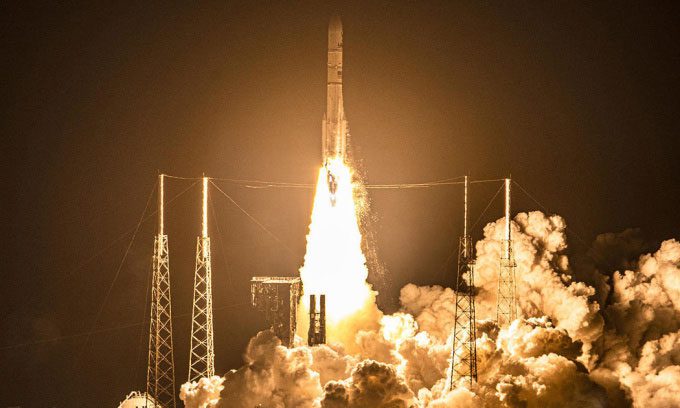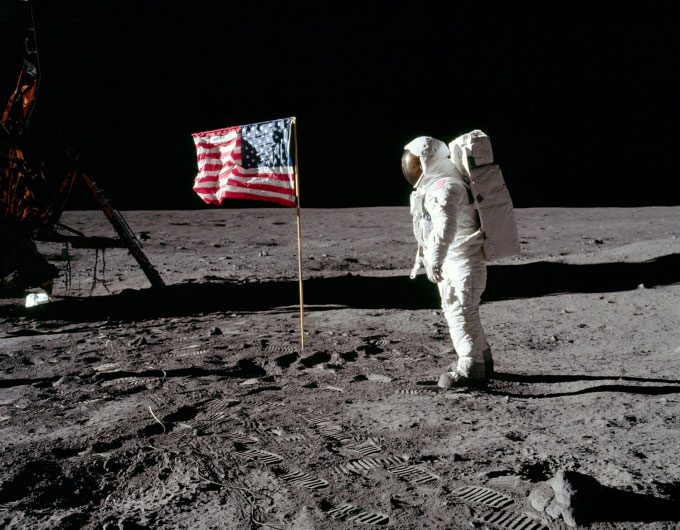The challenges in spacecraft manufacturing, landing processes, and the lack of experience among private companies have led to several recent failures of lunar landers.
At 1:18 PM on January 8 (Hanoi time), the Vulcan Centaur rocket launched into space from Florida, USA, carrying the Peregrine lunar lander. Developed by the American company Astrobotic Technology under a contract with NASA, this launch carried the hope of being the first American lunar lander to return to the Moon’s surface in over half a century.
However, shortly after launch, Astrobotic Technology discovered that the Peregrine was leaking propellant. The loss of fuel quickly diminished the lander’s chances of a smooth landing on the Moon to zero.

The Vulcan Centaur rocket carrying the Peregrine lunar lander takes off from the launch pad. (Photo: William Harwood/CBS News).
Peregrine is not the only recent failure. The Russian Luna 25 spacecraft encountered issues and crashed on the Moon in 2023, nearly 60 years after the Soviet Luna 9 conducted the first successful soft landing. To date, lunar landers created by private companies have a 100% failure rate. In addition to Peregrine, Israel’s Beresheet lander also crashed in 2019, while a lander from the Japanese company ispace fell last year.
Challenges with Lunar Landers
One of the fundamental challenges is weight, according to Jan Worner, former director at the European Space Agency (ESA). “You are always close to failure because the spacecraft must be light enough; otherwise, it won’t fly,” he said.
Moreover, most spacecraft are prototypes. With rare exceptions, spacecraft tend to be specialized machines. They are not mass-produced with the same tested and verified systems and designs. Furthermore, once in space, they must operate autonomously. “If you have a problem with your car, you can take it to be repaired, but in space, there is no opportunity like that,” Worner added.
The Moon itself presents many challenges for spacecraft. This celestial body has a gravity that is 1/6 that of Earth but lacks an atmosphere. Unlike Mars, where spacecraft can glide to the landing point and slow down with parachutes, landing on the Moon relies entirely on engines. If there is only one engine, as with most small probes, it must be steerable, as there is no other way to control the descent. The engine must also have throttling valves to adjust thrust.
Why is Moon Landing Still So Difficult Today?

Astronaut Buzz Aldrin stands with the American flag on the Moon during the Apollo 11 mission in July 1969. (Photo: NASA)
Spacecraft have successfully landed on the Moon since the 1960s. Therefore, it may seem puzzling that, after decades, the Moon remains a challenging destination.
The record of lunar missions provides a reason: Soon after the Apollo program, lunar landers fell out of favor. When China’s Chang’e 3 spacecraft landed in 2013, it marked the first successful landing on the Moon since the Soviet Luna 24 in 1976.
“For decades, there has been no development of landers. This technology is not so common that you can easily learn from others,” said Nico Dettmann, head of the ESA Lunar Exploration team.
Testing is crucial. While rockets can be fixed and tested step-by-step, options for spacecraft are more limited. The testing process can check if the electrical systems, propulsion, navigation, communication, and devices work correctly. Spacecraft can also undergo shake tests to ensure they can withstand the intense vibrations during launch. However, there is no effective way to simulate landing on the Moon.
In the space race decades ago, NASA spent up to $25 billion on the Apollo program but faced multiple failures before achieving a Moon landing. The agency now has about 70 years of knowledge and culture aimed at designing, building, and testing spacecraft.
However, under a new initiative called the Commercial Lunar Payload Services (CLPS), NASA is looking to cut costs and stimulate the US space industry by paying private companies, like Astrobotic Technology and Intuitive Machines, to deliver their payloads to the Moon.
This trade-off comes with a greater risk of failure, meaning there will likely be more landers that fail. “These companies are relatively new. Comparatively, they are also conducting these missions on smaller budgets,” noted Dr. Joshua Rasera at the Royal College of London.
But according to Rasera, this strategy will yield results as companies will learn from their failures. “Ultimately, the cost is still cheaper when considering the total number of missions, even if some of the initial missions may fail,” he stated.


















































